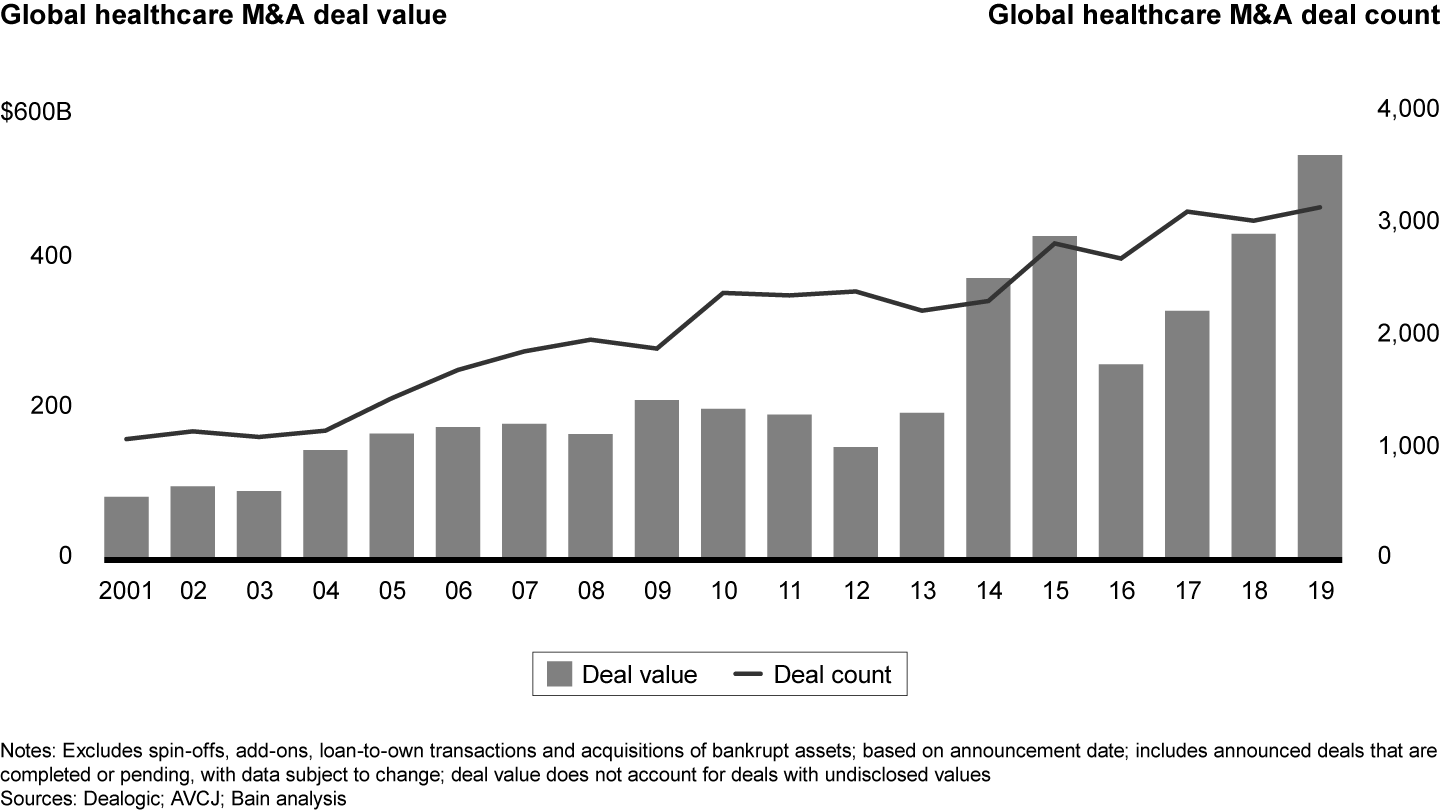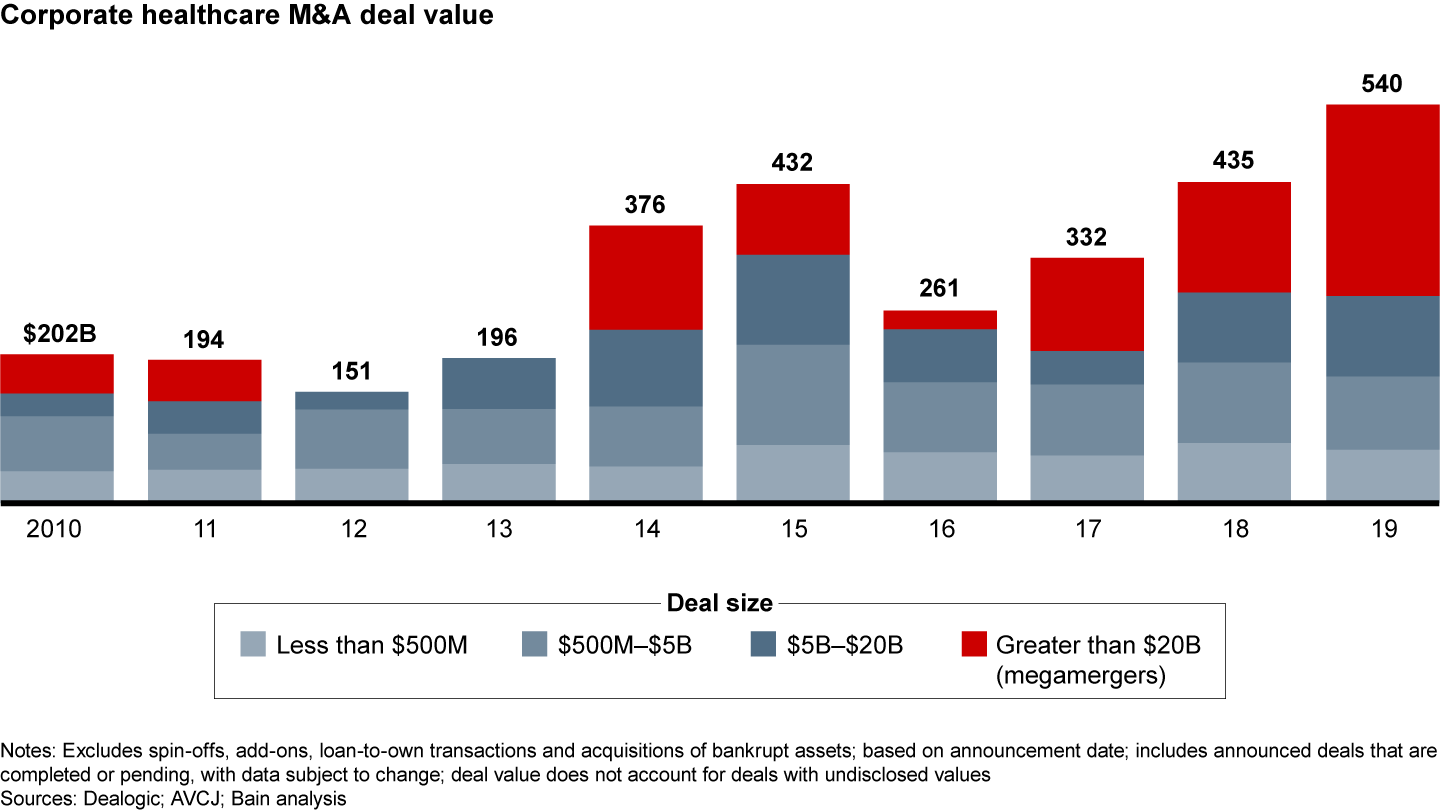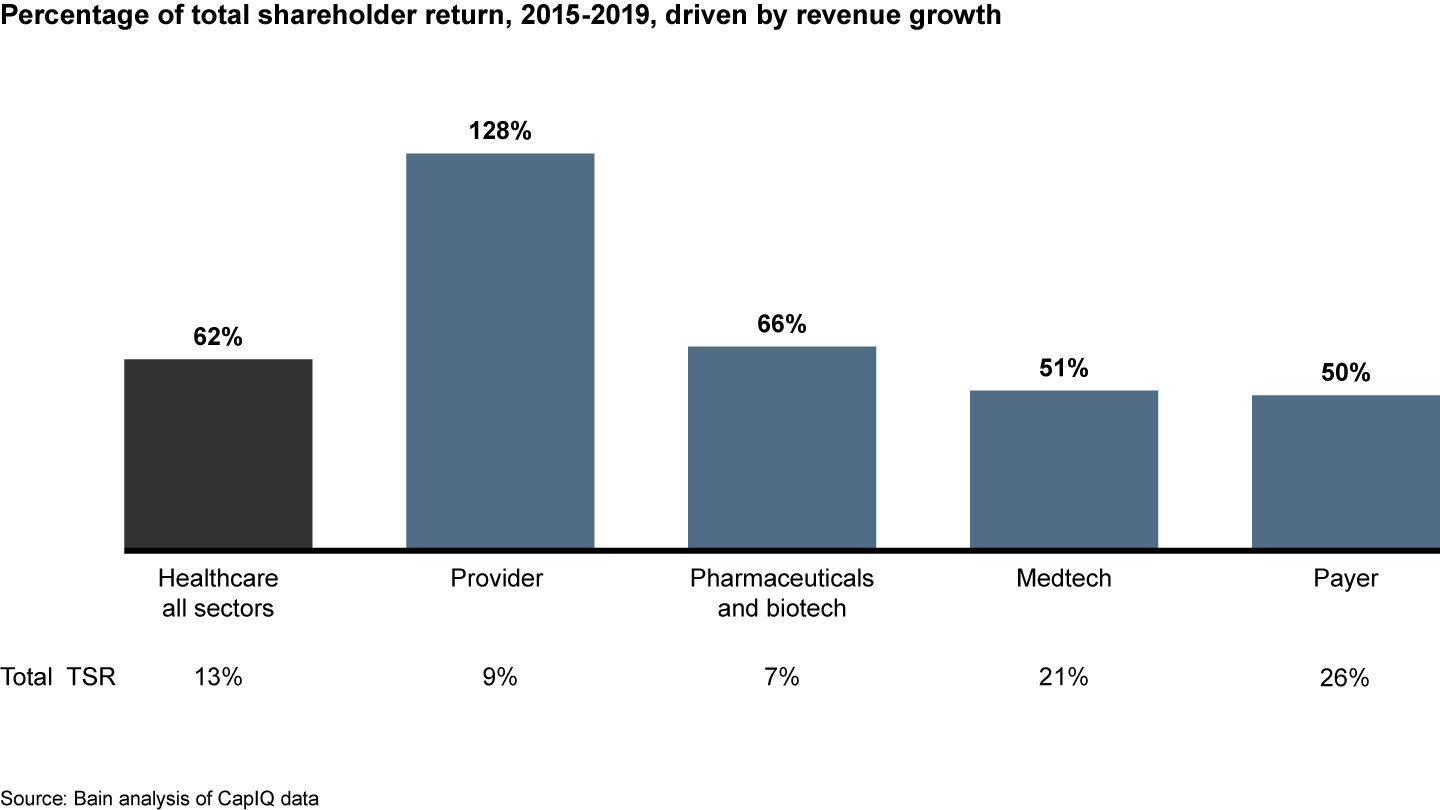Report

Executive Summary
- Disclosed deal value in 2019 rose about 24% to a new high of $541 billion, with two megamergers—Celgene and Allergan—totaling $182 billion. Deal volume grew by 4% to 3,137.
- The bid for category leadership has driven many acquisitions and divestitures, particularly in medtech and biopharma sectors.
- Partnerships of corporates with buyout funds proliferated as a way to combine different capabilities or expertise.
- Public markets are rewarding revenue growth far more than profit margin expansion, which will continue to spur M&A in the near future.
This article is part of Bain’s 2020 Global Healthcare Private Equity and Corporate M&A Report. Explore the contents of the report here or download the PDF to read the full report.
Corporate M&A in healthcare reached an all-time high in 2019, largely due to two megadeals (see Figures 8 and 9). Bristol-Myers Squibb acquired Celgene for $97 billion, and AbbVie bought Allergan for $85 billion, including net debt. We expect brisk deal activity to continue in the near future as public healthcare companies use acquisitions to grow revenue, which public markets continue to differentially reward relative to profit margin expansion.




Corporates will also continue to explore opportunities at the intersection of healthcare, financial services, technology and consumer markets. For example, JPMorgan Chase acquired InstaMed, a healthcare payments company.
Simultaneously, corporates have been divesting underperforming or noncore businesses and outsourcing noncore activities. Each trend provides PE funds with opportunities to creatively partner with corporates, back smaller companies that ride the outsourcing wave and acquire divested assets. For any company doing M&A, it is essential to develop a well-articulated value creation plan in the current competitive and expensive market.
The largest M&A deals of the year were concentrated in the biopharma and medtech sectors, which saw 9 of the top 10 deals. With biopharma, the two megadeals mentioned earlier allowed the companies to develop more stable future cash flows and mitigate lost sales from upcoming patent expirations.
AbbVie’s acquisition of Allergan delivers strong and stable cash flows from medical aesthetics as the company braces for the expiration of Humira, the top-selling drug in the world but one that will face competition from biosimilars as early as 2023.
Bristol-Myers Squibb’s acquisition of Celgene will result in an impressive combined oncology portfolio with nine drugs that have more than $1 billion in sales. Celgene’s late-stage pipeline assets should help offset lost sales from its own blockbuster multiple myeloma drug, Revlimid, which loses patent protection in 2022.
Outside of these two megadeals, M&A theses followed familiar patterns over the past two years.
Biopharma: Smaller assets or new platforms
In biopharma, two traditional approaches prevail as corporate acquirers have looked to improve their R&D pipelines with an eye toward developing their future growth prospects. First, companies bought smaller companies or individual assets within their own areas of expertise, typically following a milestone that results in the asset shedding risk.
Pfizer thus acquired Array BioPharma, which specializes in small molecule drugs targeting cancer, for $11.4 billion. The deal strengthens Pfizer's category leadership in oncology with breakthrough BRAF/MEK inhibitor combination therapies and potential first-in-class treatments for BRAF-mutant metastatic colorectal cancer.
The second approach involves entirely new technological capabilities or platforms such as cell and gene therapy. For example, Roche bought Spark Therapeutics, which specializes in gene therapies, for $4.8 billion, to gain access to a gene therapy platform. And Pfizer purchased a 15% stake in Vivet Therapeutics, a French gene therapy company.
Medtech: Enhancing category leadership while keeping an eye on regulatory developments
In medtech, many companies looked to consolidate their market share in areas where they have a path to category leadership, and divest subscale positions where they do not see a path. For example, Stryker’s $5.4 billion acquisition of Wright Medical Group will bring additional scale to Stryker’s fast-growing extremities business.
Evolving regulations will warrant scrutiny during due diligence. In Europe, the shift in Medical Devices Regulation (MDR) to make reviews more strenuous will take effect in mid-2020. As acquirers consider medtech companies with significant revenue in Europe, diligence should include plans to address any costs or revenues associated with MDR. While the US Food and Drug Administration (FDA) is unlikely to make any major process changes in the near term, any revisiting of the 510(k) pathway would yield significant consequences for medtech companies, potentially requiring recertification of several on-market devices.
Payer: National companies look to build out their capabilities and noninsurance offerings
After a number of megadeals in 2018, including Aetna/CVS and Cigna/Express Scripts, deal value in payer and related services declined in 2019. However, multibillion-dollar transactions have still occurred as national payers look to build out their breadth of capabilities and noninsurance offerings.
A good example is UnitedHealth Group’s $3.2 billion purchase of Equian, the healthcare payments firm, from New Mountain Capital. UnitedHealth has merged the firm with its Optum business unit to add additional capabilities.
US health insurers also vertically integrated to differentiate themselves and develop new models for growth. Centene acquired WellCare Health, a provider of managed care services, for $17.3 billion, making it the largest Medicaid managed care company and expanding its Medicaid Advantage business.
Divestitures play to category leadership
With category leadership a favored strategy across sectors for acquisitions, corporates selectively bought regulatory-mandated divestitures, which often stem from category leadership plays. For example, the FTC mandated that Celgene divest its psoriasis treatment, Otezla, as part of the BMS acquisitions, and Amgen acquired Otezla.
We also note that larger companies divested noncore assets with subscale positions in order to focus on higher-return areas. Pfizer is a case in point, with a multiyear effort to rationalize its portfolio as it doubles down on patented drugs in areas such as oncology. Pfizer announced its discussions with Mylan to complete a potential spin-off of its Upjohn business.
Partnerships with PE funds flourish
Partnerships of corporates with buyout funds proliferated during the year, as a way to combine different capabilities or expertise. Welsh, Carson, Anderson & Stowe and Walgreens invested in Shields Health, a specialty pharmacy services provider. Shields cited the advantages of blending Welsh Carson’s experience in the healthcare industry with Walgreens’ extensive operating experience.
Partnerships extended outside of M&A as well. For example, Walgreens and VillageMD, a venture-capital-backed primary care provider, collaborated to open clinics that integrate primary care services with pharmacy services.
Besides the value of partnerships, corporate interest also represents a potential exit route for private equity funds at the end of the holding period. For example, Apax Partners, CPPIB and PSP sold Acelity, a medical equipment and supplies manufacturer, to 3M for $6.7 billion in the largest healthcare exit of 2019. Anthem acquired Beacon Health Options, a payer in behavior health, a proof point on the value of investing in a scale platform with scarcity value in the payer space.
Outlook: Bring on the revenue growth
M&A looks set to continue its importance over the next few years as public healthcare companies strive to grow revenues. When it comes to total shareholder return (TSR), new Bain & Company analysis of CapIQ data shows that revenue growth accounts for about 62% of TSR over the past five years, a far more important factor than profit margin expansion, which accounts for 9% (see Figure 10). Transactions thus will supplement organic growth as companies use all available levers.


This article is part of Bain’s 2020 Global Healthcare Private Equity and Corporate M&A Report. Explore the contents of the report here or download the PDF to read the full report.